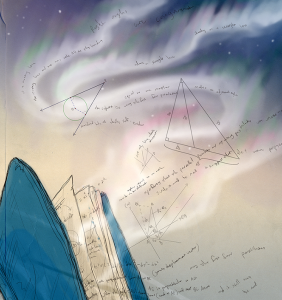An essay by Desmond Ashmore, as provided by James Hanson
Art by Leigh Legler
January 26th, 1875, At Sea
The purpose of our expedition as stated in our charter is twofold: to determine the ultimate fate of Baxendell’s expedition of 1869, and to recover as much of their personal effects and scientific equipment as possible, with special emphasis on Oxford’s astrographic lens and the Royal Society’s Synthetical Engine No. 2. Truthfully I have another, personal purpose in this endeavour, which is to vindicate Sir Arthur Baxendell, who has always garnered my deepest admiration, both in his capacity as a physicist and, despite my habitual distaste for the profession, as a mathematician.
The skipper says that we are about a day away from the Great Ice Barrier where we now know they should have landed. At first, when nothing was heard from them, it was assumed that they had overwintered twice on the peninsula where they were originally intended to land. It was feared the HMS Resolute had become trapped in ice, but two relief ships, the HMS Erebus and the HMS Racehorse, failed to find anything.
Eventually, it was supposed that the ship had sunk on the journey from the Florida Colony to Antarctica. But at some point around 1872, the HMS Resolute was spotted ice-locked by the Japanese whaling ship the Kiji Maru, although they did not recognise it and they had neither the ability nor the interest to investigate it. Japan’s trade isolation meant that the news was slow to spread to Europe, and after having been filtered by the Japanese and then the Dutch, all that arrived in the United Kingdom was a rumour that an English ship was abandoned in Antarctica.
Fortunately, an English diplomatic envoy has been in Japan attempting to negotiate the opening of trade and, at the request of the Royal Society, they enquired after more specific details regarding the spotted ship. It came to light that a vital datum has been caught in the filtration: for some unknown reason, instead of landing on the Graham Land Peninsula in the Weddell Sea, the expedition had landed on nearly the opposite side of West Antarctica, on the Great Ice Barrier.
And so, as it had been so long, a search party was formed rather than a third relief party.

In what must have been all of his mathematical notes he had ever written I eventually found the “proof” he mentioned. He was not exaggerating when he said that it was technically challenging, but so are all proofs of absurd falsehoods. I remember that in my school days, similar “proofs” of the equality of one and two would be passed between boys with the hunched secrecy normally reserved for the trading of literary smut and tobacco, for the punishment for propagating mathematical nonsense was nearly as harsh.
To read the rest of this story, check out the Mad Scientist Journal: Summer 2014 collection.
Desmond Ashmore is an astronomer and fellow at the University of Cambridge. He is best known for making spectroscopic observations in India during the eclipse of 1868 which lead to the discovery of the hitherto unknown element Solium, which comprises the atmosphere of the Sun.
James Hanson is a physics graduate student at the University of Wisconsin-Madison. He often finds himself torn between his love of cerebral hard science fiction and his fondness for bad 50s-era special effects. This is his first publication since high school.
Leigh’s professional title is “illustrator,” but that’s just a nice word for “monster-maker,” in this case. More information about them can be found at http://leighlegler.carbonmade.com/.
Follow us online: